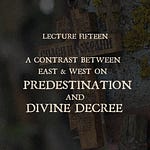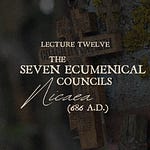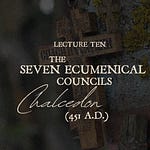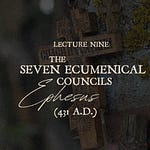These are transcripts from a spoken lecture. The audio is attached to this lesson. If there is any confusion from reading the transcript, please refer to the audio for clarification.
So last time we talked about the fall and the corruption of man, we discussed the fact that man is an icon of God, which makes us naturally susceptible to the attributes of God, and we talked about the ways in which the fall inverts our higher and lower nature, elevating the lower nature in a way that subjugates the higher nature to the passions, the way Paul and James and others talk about in Scripture. We also talked about this war between the Creator God and the anti-creator that is the devil, and the ways in which God being providential and being good, which, according to the eastern fathers, really means that he wills the good of a creature, is always bent on drawing creatures, not only into existence, but to our proper good.
And this is why the demonic rebels are bent on undoing that providential act and distorting our nature. This is where corruption enters the story as part of the demonic rebellion. We also saw the way in which when the Creator God, and specifically the agent of creation, that is the second person of Trinity, the Son of God, the logos, sees this demonic rebellion, that the solution to this is ultimately to become a creature himself, to enter the creation as one of us. And in doing that, he does so, according to the eastern fathers, in order to fix our nature from within, unmaking humanity, undoing the corruption from within and restoring that icon back to its original shape, so that in the resurrection from the dead, his resurrection from the dead, we see the first real human being, something that has never been seen on the face of the earth before that.
Today, I had said in our last session that we are going to transition into the next topic, which is, how do we begin to participate in this redemption that the logos the Son of God has enacted on our behalf? But that’s actually not true. That’s not quite where we’re going next. That’s actually the next lecture after this. Where I wanted to go before we touch on that is to an aspect of the work of the Son of God that has been more or less lost in western theology, but is just as critical to the eastern fathers and drawing from scripture, Scripture itself to the work of Christ. And that doctrine concerns what’s sometimes called in the east, Holy Saturday, or Christ’s descent into Hades.
So Holy Saturday is so named because it refers to that period between Christ’s death and his resurrection, and what happens in that time period? What is he doing? And the answer to that question, according to the fathers, is clear in Scripture, and it is ultimately redemptive, as redemptive for humanity, as his crucifixion and ultimately his resurrection. So what is that doctrine that is going to be the focus that we have today? And it’s the focus because I really want us to be able to round out this talk of the work of the Son of God on behalf of humanity, before we move on to the question of, how do we enter into the benefits of this redemptive act?











